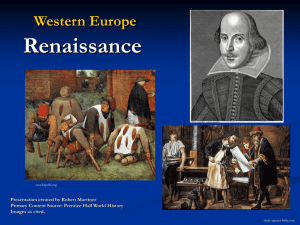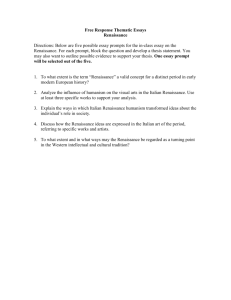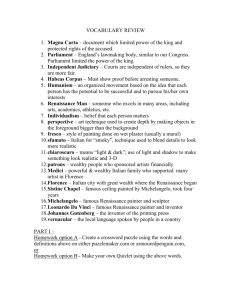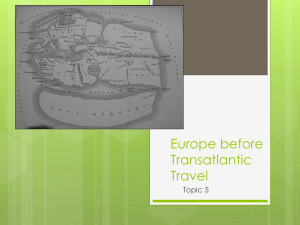From Renaissance to Reformation - Mr. Harrison's History/law Site
advertisement
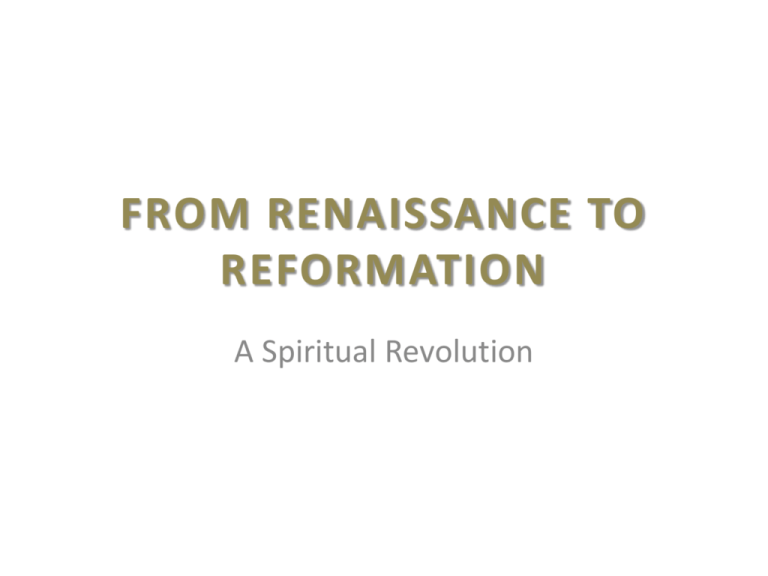
FROM RENAISSANCE TO
REFORMATION
A Spiritual Revolution
Learning goals
• By the end of this lesson, students will:
– demonstrate an understanding of diverse social structures
and principles that have guided social organization in
Western and non-Western societies since the sixteenth
century
– demonstrate an understanding of ideas and cultures from
around the world that have influenced the course of
history since the sixteenth century
THE RENAISSANCE – LOOKING BACK
•
RENAISSANCE = rebirth
–
–
–
–
refers to the re-emergence of trade and culture in Europe
began in Italy, spread to influence all of Europe
exchange of goods and ideas initiated cultural development
being able to achieve greatness = Renaissance Man
SUPPORTED BY A NEW PHILOSOPHICAL APPROACH
•
HUMANISM
– Emphasized the 3 ‘isms’
• INDIVIDUALISM - glorifying potential, talents and accomplishments of
individual human beings.
• SECULARISM - emphasis on this world (the “here & now”) and its material
pleasures rather than the afterlife (“hereafter”) or spiritual world.
• CLASSICISM - Re-discovery and appreciation of ancient Greek & Roman
culture
NORTH VS. SOUTH
N ORTHERN R ENAISSANCE
E NGLAND, N ETHERLANDS
S OUTHERN R ENAISSANCE
I TA LY
• Less secular
• Employ reason and intellect
to explain and strengthen
religious belief
• Challenged institution of
Church (drifted from JC)
• Strong monarchies
• Very secular
• Use reason and intellect to
improve humankind
(politics, art, philosophy)
• Did not abandon faith
• Italian city-states loosely
organized republics
THINGS IN COMMON:
- stressed rationality and man’s ability to reach full potential (humanism)
- diminished importance of Catholic Church
Great Men of the
Renaissance
{ THE ‘BIG 5’
LEONARDO DA VINCI
• Bio stuff:
– Full name: Leonardo di ser
Piero da Vinci
– Italian painter, sculptor,
architect, mathematician,
engineer, inventor, anatomist,
geologist, cartographer,
botanist, writer
– Best known for:
•
•
•
•
Mona Lisa
Last Supper
Vitruvian Man
Virgin on the Rocks
MICHELANGELO
• Bio stuff:
– 1452-1519
– Full name Michelangelo di
Lodovico Buonarroti
Simoni
– Italian sculptor, painter,
architect, poet, and
engineer
– Best known for:
•
•
•
•
•
David
Pieta
Sistine Chapel ceiling
Birth of Adam
Last Judgement
NICCOLO MACHIEAVELI
• Bio stuff:
– 1469-1527
– Full name: Niccolò di Bernardo dei
Machiavelli
– Italian historian, politician,
diplomat, philosopher, humanist
and writer based in Florence during
the Renaissance.
– Best known for:
• Political science
• The Prince – political ethics
• Machiavielian principles:
– subtle or unscrupulous cunning,
deception, expediency, or
dishonesty: He resorted to
Machiavellian tactics in order to
get ahead.
» Dictionary.com
SIR THOMAS MORE
• Bio stuff:
– 1478-1535
– known to Roman Catholics
as Saint Thomas More
since 1935, was an English
lawyer, social philosopher,
author, statesman and
noted Renaissance
humanist
• Best known for:
– Utopia (book)
– Execution by Henry VIII
DESIDERIUS ERASMUS
• Bio stuff:
– 1466-1536
– known as Erasmus of
Rotterdam, or simply Erasmus,
was a Dutch Renaissance
humanist, Catholic priest, social
critic, teacher, and theologian.
– Erasmus was a classical scholar
who wrote in a pure Latin style
• Best known for:
• The Praise of Folly (essay)
• Critic of the Catholic Church
• Translated New Testament from
Greek to Latin
• ‘Prince of the Humanists’
CONTINUITY – MIDDLE AGES TO
RENAISSANCE
• So…what stayed the same?
1. The Honour Code – belief that a code of ethics
should govern humankind (be humble,
retribution)
2. The Family – most important solidarity in history
(residence, love, property rights, production,
marriage for connections – not love)
3. Social Hierarchy – reinforced social distinctions
of high and low
CHANGE – MIDDLE AGES TO
RENAISSANCE
• So…what changed?
1. Intellectual Culture - fields of law, philosophy, politics,
history, literature, medicine, philology (study of
vocabulary)…grew
2. Art and architecture - Roman domes, arches, columns
return, statues (nude), old themes in painting, invention
of linear perspective
3. Learning - admiration of the ancients; print – moveable
type (Gutenberg) made information readily available,
promoted vernacular languages (English, French…)
What’s next?
With
the intellectual and cultural
transformation in place, the European
Reformation would usher in a spiritual
revolution. From the Spanish Inquisition to
the wars of religion, Europeans would
experience religious civil war lasting for
nearly a century and a half. It’s effects
would be profound…the world of 1450
would be re-invented forever.
Source: Legacy: The West and the World
